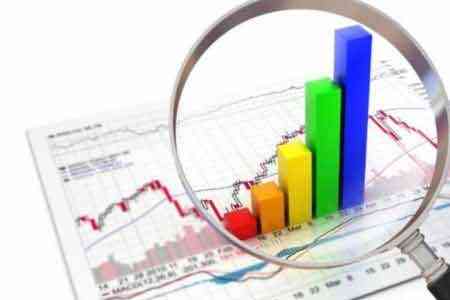


ArmInfo.The Central Bank of Armenia has revised its GDP growth forecast for 2025 from the previous range of 7-4.5% to a new range of 5.1-4.6% (compared to the actual 5.9% growth in 2024). The Central Bank has also adjusted its GDP growth forecast for 2026, now anticipating a slowdown to 4.9-4.4%, instead of the previous 4.7-7% (depending on the inflation trajectory).
As a result, the absolute value of GDP is expected to increase in 2025 to 11.077-11.032 trillion drams (up from 10.193 trillion drams in 2024), and then potentially reach 12.3-12.2 trillion drams in 2026, as noted in the report of the Central Bank of the Republic of Armenia "Monetary Policy for the II quarter of 2025" published on June 17.
With the transition to the new and improved system for developing monetary policy (FPAS MARK II), the Central Bank started calculating the GDP forecast based on Case A and Case B scenarios starting in 2024. In Case A scenarios, monetary policy rates are assumed to be higher than exceed market expectations, as risk and uncertainty factors can lead to a more inflationary environment in the economy. Case B scenarios assume lower monetary policy rates than market expectations, as risk and uncertainty factors can result in a deflationary or low inflation environment in the economy. In Case A scenarios, there is an expansion of demand and a curb on supply, while in Case B scenarios, there is a curb on demand and an expansion of supply.
It is worth noting that inflation forecasts for 2025 have been significantly revised in the new forecast, increasing from the previous 2.6-2.4% to an updated 3.4% (according to Case A) and 3.2% (according to Case B), against an inflation rate of 1.5% in 2024. By 2026, inflation ix expected to approach to the updated target level (3%, +/- 1 p.p.) - up to 3.2% (according to Case A) or up to 2.9% (according to Case B). Moreover, inflation in the segment of non-exportable goods, which is characterized by rigid prices, is projected to increase to 2.7-2.6% (from 2.5% in 2024) in 2025, and continue to rise to 3.5-2.8% in 2026.
According to the updated forecast of the Central Bank, the dynamics of exports and imports are expected to change. In 2025, there will be a decline of 32.3-36.4% (for exports) and 29-34.2% (for imports), following almost identical growth of 35,6-31,4% in 2024. In 2026, the Central Bank predicts an improvement. with exports growing 5.4-5%, and imports by 4.7-3.1%. Compared with the previous March forecast, there is now an even more noticeable decline expected for both exports and imports in 2025. with an improvement in the trend of both exports and imports in 2026. The ratio of the current account deficit to GDP is projected to be 4.7% (according to Case A) or 3.3% (according to Case B), after reaching a positive 2.8% in 2024 (up from negative 2.3% in 2023). In 2026, this indicator will remain negative at 4.4% (according to Case A) or 2.5% (according to Case B).
The ratio of remittances to GDP will decrease in 2025 to 3% (after increasing from 4.1% to 6.2 % in 2024), and then in 2026 will remain at the level of 3-3.1%. This fixes the duration of the weakening of the economic effect in terms of the impact of transfers on the economy. The Central Bank's forecast for budget revenues and expenditures for 2025 remains changed: expenditures will grow more noticeably - from 2.9 trillion to 3.4 trillion drams, than revenues - from 2.6 trillion to 2.8 trillion drams, as a result of which the state budget deficit will increase from 319.2 billion to 604.1 billion drams. As a result, in 2025, the ratio of the state budget deficit to GDP will increase from 3.2% to 5.5%, with a slight increase in the share of revenues in GDP from 25.4% to 25.6-25.7% and a more noticeable increase in the share of expenditures in GDP from 28.6% to 31.1-31.2%. The report by the Central Bank of the Republic of Armenia also provides forecasts for economic development and inflation in the United States, the Eurozone, and the Russian Federation, for oil and copper prices, and for the FAO index.
The US economy is expected to slow down in 2025 to 2% (from 2.8% in 2024) and inflation to weaken from 3% to 2.8%. The Eurozone economy will slightly accelerate in growth in 2025 to 1% (from 0.9% in 2024), with inflation weakening from 2.4% to 2.1%. The Russian economy will stall in growth in 2025 to 1.6% (from 4.3% in 2024), with inflation remaining at 8.4%. In 2026, the US economic growth will slow down to 1.9-1.5%, the Eurozone will slightly accelerate to 1.1%, and Russia will remain at 1.6%, with inflation in the US, the Eurozone and Russia continuing to decline to 2.7-2.6%, 2-1.8% and 4.9-5%, respectively. The oil price, according to the new forecast, will fall from $80.5 in 2024 to $65.5-65.3 per barrel in 2025 and further to $61.3-60.7 in 2026. The price of copper, unlike the previous forecast, will increase more noticeably - from $9142.1 per ton in 2024 to $9441.1-9426.7 per ton in 2025 and further to $9762.1-9702.7 in 2026. The FAO index, after declining in 2023-2024 from 124.1 to 122, will begin to grow in 2025 - reaching 129.9-129.7, and then in 2026 will continue to grow to 133-132. Then, in 2027, copper will continue to rise in price, the FAO index will increase slightly, and the price of oil will decrease even more.